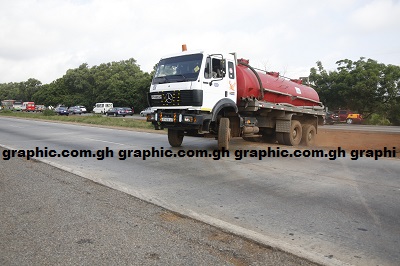
Accra-Tema motorway loses shine; slums, illegal U-turns reduce road to 'street'
Uauthorised settlements and slums along the Accra-Tema Motorway, coupled with the creation of illegal U-turns, have become a source of concern to motorists who ply the 19-kilometre highway.
The situation has led to a disregard for road traffic regulations and the advent of stagnant ‘pools’ and heaps of filth along that stretch of road.
The slums, consisting of kiosks and metal containers, are concentrated in the area from the tollbooth at the Accra end of the motorway to the Community 18 Junction in Tema.
Referred to as "kiosk estates", the slums have become dens for robbers and other miscreants, some of who sometimes emerge from their shacks to rob owners of vehicles that break down on the road at night of their valuables, including car batteries.
Advertisement
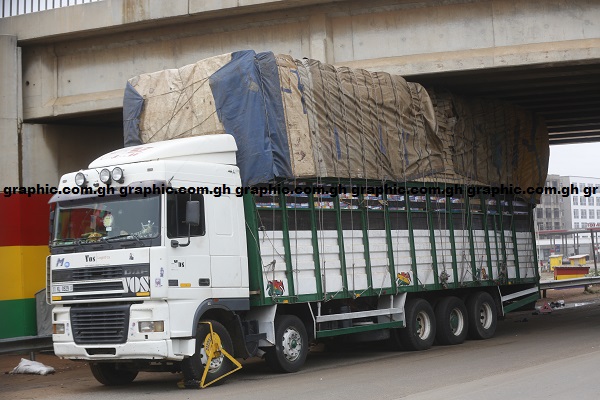
A heavily loaded truck stacked under the Ashaiman overhead bridge
The residents, according to claims by the Ghana Highway Authority (GHA), are also responsible for the darkness on the road because they steal copper wires used to connect power to the streetlights erected on the motorway in 2011.
As a result of the illegal settlements, trotros, taxis and motorbikes often stop haphazardly on the highway to pick and drop passengers at will, despite the fact that vehicles are not supposed to stop on the highway.
And, most of the time, those commercial drivers fail to give signals of either stopping or getting back onto the road, leading to other vehicles crashing into them.
As a result of the lack of waste disposal receptacles and toilet facilities in the slums, the residents dump refuse anyhow and also defecate in the bushes along the road.
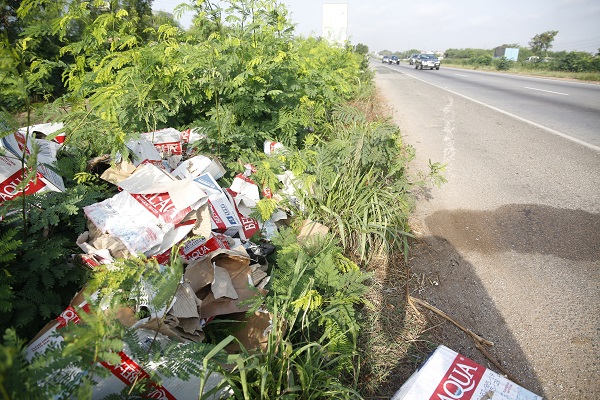
Refuse dumped on the shoulder of the motorway
Situation in slums
A tour of the slums by the Daily Graphic further revealed that even though settlement there was illegal, the structures enjoyed electricity and water supply.
There were also brisk business activities, such as the sale of alcohol, cigarettes, commodities, foodstuffs and other items.
Some of the slums have video centres, parks for social activities and mini-football pitches.
It was also established that not all the structures were on government land; a few were situated outside the Motorway Reservation on private lands.
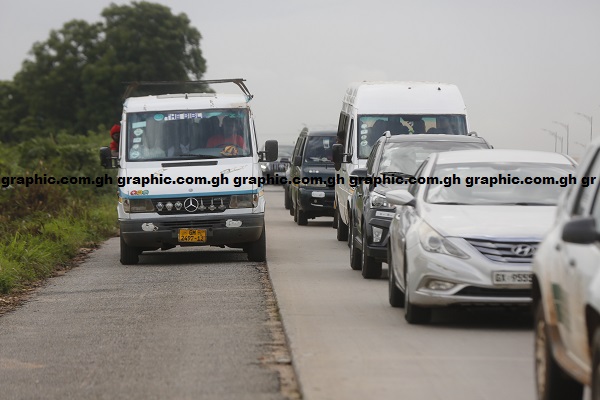
Some drivers using the shoulders of the road on the Tema-Accra Motorway
At the KICC slum, named after the Kingsway International Christian Church (KICC), a community leader, Felix Adzakpa, claimed that the number of people residing there was more than 10,000.
"If you come here on a Sunday after church, when almost all residents are at home, you will have a fair idea of the number of people who live here. We are more than 10,000," he said.
He admitted that they did not acquire the land from any authority, saying: "When we came here, the entire area was bushy. It was like a forest.
We cleared the place and erected our structures. Later, the Electricity Company of Ghana (ECG) provided us with electricity and the Ghana Water Company also connected water to this place," Mr Adzakpa stated.
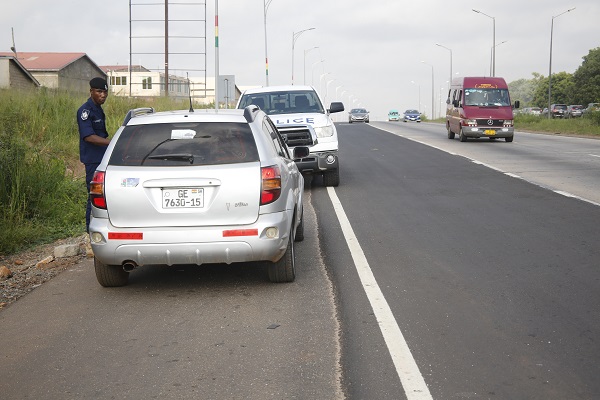
A police officer cautioning a driver caught in the act
According to him, some of the dwellers of the slum had lived there for more than 10 years, and that the settlement came up slowly, over a period of 15 years.
He, however, denied that the slums were havens for criminals and said, on the contrary, the residents had been of help to motorists.
Mr Adzakpa said any time a vehicle broke down on the motorway, dwellers of the slums stood guard over the vehicle and its driver until the driver secured the services of mechanics.
And when accidents occurred, he added, the residents provided support for victims, some of whom they sometimes rushed to hospital.
"The only problem we have here is that people smoke marijuana in the open and that is bad," he said.
He appealed to the government not to eject them because they did not have alternative dwelling places.
At another slum, known as "Trasacco" due to its proximity to the Trasacco Valley Estates, a community leader, Gideon Mate, said the residents were ready to relocate any time the need arose.
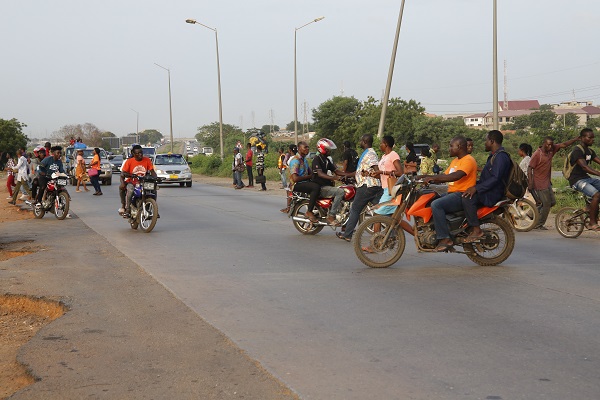
U-turns
The illegal U-turns on the motorway have been the cause of many accidents on the road.
A drive along the stretch revealed dangerous turns by both private and commercial vehicles.
There are about 40 illegal turns and paths along the entire stretch of the road, with the GHA blocking six of them with concrete boulders.
Reactions
Reacting to the slum development, the Greater Accra Regional Director of the GHA, Mr Lawrence L.L. Lamptey, said the
Executive Instrument (EI 46) from which the motorway land was acquired barred individuals or groups from erecting structures 90 metres or 250 feet from the middle of the highway.
He said going by that measurement, most of the illegal structures, including some factories on the motorway, fell within the reservation.
According to him, when the highway was constructed in the 1960s, concrete and metal pillars were used to demarcate the land but most of those warning signs had been removed by the encroachers.
Mr Lamptey attributed the usual flooding of portions of the road to the illegal U-turns and walkways created along the road.
He explained that when the highway was constructed, a drain was built in the median to channel rainwater into pipes under the road, but due to the activities of the slum dwellers, some of the drains had become silted.
According to the director, the illegal structures would be demolished soon to make way for the expansion of the motorway.
He alleged that anytime officials from his outfit wanted to ensure sanity in the area, they were threatened by the slum dwellers and said the authority would liaise with the Bureau of National Investigations (BNI), the Ghana Police Service and the Ghana Armed Forces to carry out the demolition exercise when funds were made available.
Mr Lamptey further revealed that the GHA would erect concrete barriers along the entire motorway to make it impossible for people to cross from one side to the other, just as had been done at the Ako Adjei and the Kwame Nkrumah interchanges.
That project, he said, would cost about GH¢120 million, adding: "If this is done, pedestrians and vehicles which want to get to the other side would have to walk or drive all the way to the end of the motorway and turn."
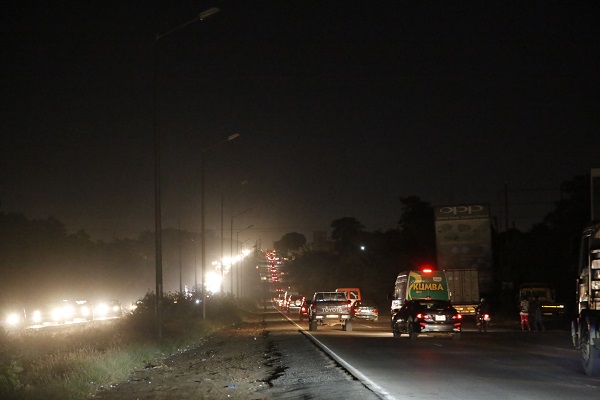
Responsibility
The Tema Development Company (TDC) laid the problem at the doorstep of metropolitan, municipal and district assemblies in whose jurisdictions the illegal structures were situated.
The Protocol and Administrative Officer of the TDC, Mr Ian Tabalor Okwei, said the assemblies needed to be proactive by demolishing such illegal structures.
For his part, the Chief Executive of the Adentan Municipal Assembly, Nii Noi Adumuah, in whose jurisdiction the Trasacco slum is situated, blamed the media for the phenomenon.
He said anytime assemblies took action on such matters, the media were the first to publish articles accusing the authorities of cruelty towards slum dwellers.
The Tema Metropolitan Chief Executive, Mr Felix Nii Anang-La, also said a resettlement plan for the dwellers was being drawn up by the assembly.
He said it was being drafted in collaboration with the Ministry of Roads and Highways.
According to him, the Ministry of Roads and Highways was ready to release $1 million for the acquisition of land in the Amasaman area to resettle some of the motorway slum dwellers.



